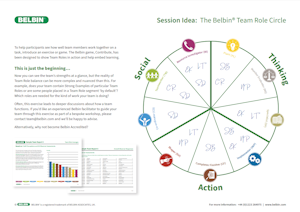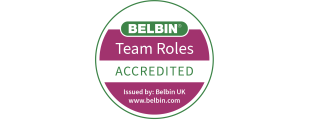Ideas, handouts and other resources
Here's a selection of useful resources to help you and your team get the most from the reports. We hope you find them useful.
If you are a HR/L&D professional or management consultant using the reports and theory to help teams collaborate more effectively, there are training options specifically for you.
Belbin Team Role Descriptions
A one-page handout that summarises the strengths and allowable weaknesses for each of the nine Team Roles. This is also printed as page two of the Belbin Individual and Team reports.
Download
How to use your Belbin Individual report
A six-page exercise to work through once an individual has their full Individual report (including Observer Assessments). Aimed to give a better understanding on the contributions made to the team. Often used during a 1:1 coaching session, or given as a reflection exercise.
Download
Team Roles in a Nutshell
A useful three-page handout that explains the theory of Team Roles and introduces the concept of strengths and allowable weaknesses.
Download
Belbin Team Role Circle Exercise
A four-page handout illustrating how to use the Team Role circle exercise, and how to use it to identify (and devise strategies around) collective team strengths and weaknesses. A good starting point for any team session.
Download
Exercise: How to work together
Taken from the webinar - Using Belbin to form high-performing teams. An exercise to use with Belbin Individual reports to hand. Team members work in pairs to discuss how to work together using the language of Belbin and the content of their reports.
Exercise: Turbo-charge your CV
Your Belbin Individual report can help you in your career, and when looking for a new role. Campbell Urquhart from Belbin Scotland explains how the information contained in your report can be used to help your CV stand-out.
How to use Belbin reports to raise self-awareness and increase personal effectiveness (45 minutes)
Everyone has something to contribute to a team, but it can be difficult to establish and articulate exactly what that contribution might be. During this 45-minute webinar we take you through the Belbin Individual report step by step, and explain how you can use it to help improve self-awareness and personal effectiveness.
How to use Belbin reports to integrate a new team member (45 minutes)
The objective of recruitment is clear: to ensure that the right person is given the job – someone who can work well with the existing team and add value to the company.
Effort is needed to integrate new starters and ensure that they understand – and can fulfill – their new role within a team setting.
This webinar shows you how to use the Belbin theory and reports to help with that crucial on-boarding process.
How to design and run more effective meetings with Belbin (35 minutes)
We know that meetings are an essential communication tool in projects and teamwork.
Meetings keep us informed about progress and enable us to make better decisions. If done right, meetings also help us to collaborate, nurture relationships and exchange information.
So how can we use Belbin to make meetings better?
Useful publications

The Crisis Team Exercise
Rob Groen from Belbin Netherlands demonstrates how to help team members appreciate the importance of diversity in a successful team. This article was first published in Training Journal.

When four worlds collide
Talan Miller (Belbin Australia) blends Team Role theory, Tuckman’s model, Situational Leadership and neuroscience to show how leadership changes as a team develops. First published in Training Journal

A Beautiful Mind
Meredith Belbin’s pioneering insights into the make-up of effective teams took the world of work by storm in the 1970s. Thirty years on, for all the competition, Belbin’s team profiles remain as popular and profitable as ever. Jane Lewis went to meet the grandfather of modern psychometrics. First published in Edge Magazine
Contact us
Please fill out the form and we'll be in touch.
Belbin Training and Workshops

Practical Belbin Workshop
A 'train the trainer' hands-on workshop to help you understand how to use Belbin Team Roles - to help you, your managers, teams and organisation!
Find out more
Team Workshops
If you are experiencing problems with particular people or teams, then a Belbin workshop could be the answer.
Discover more
Belbin Accreditation
Belbin Team Role Accreditation is recommended for anyone who wants to use Belbin Team Roles to improve the performance of teams, and maximise working relationships.
Accreditation